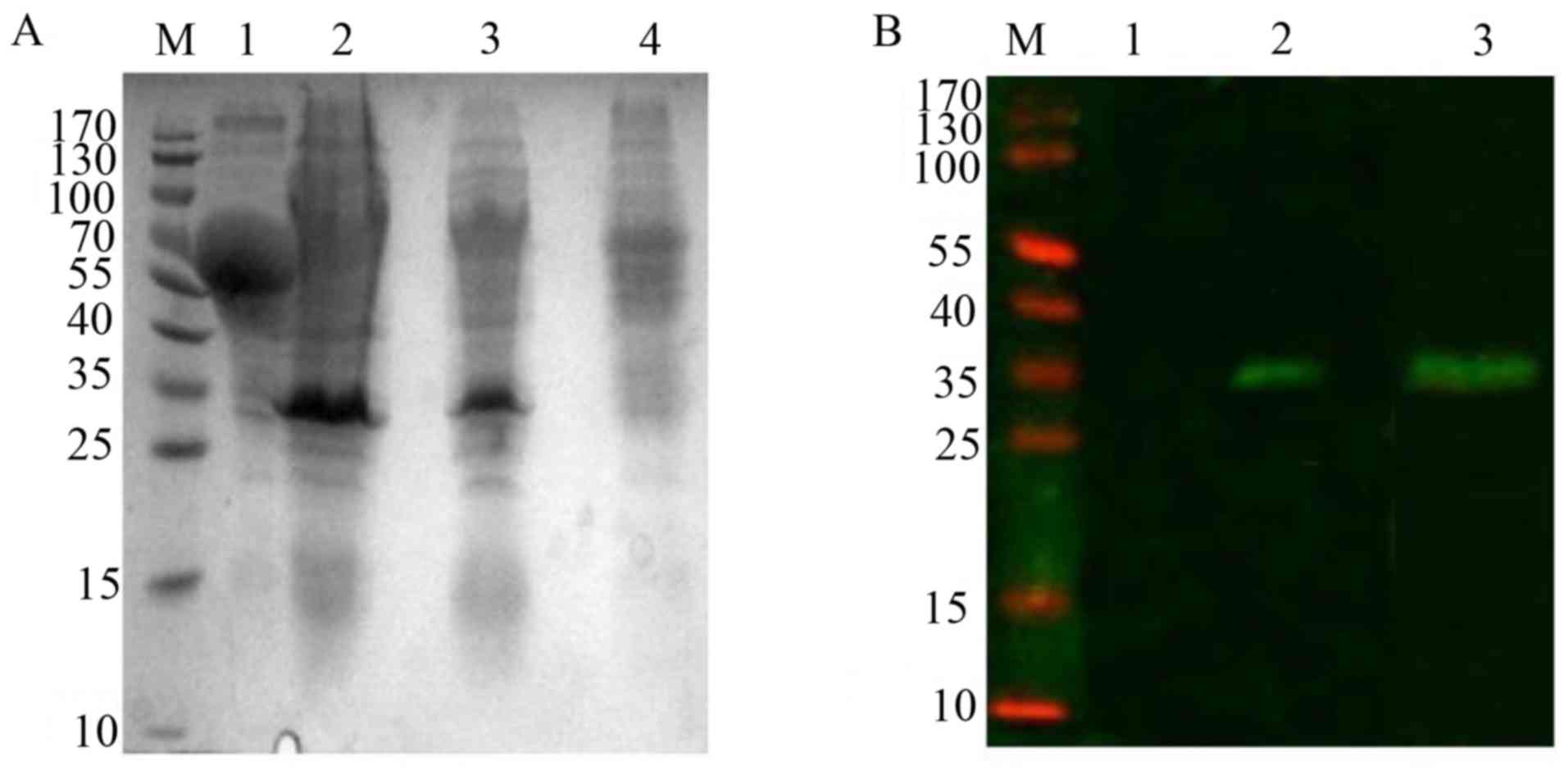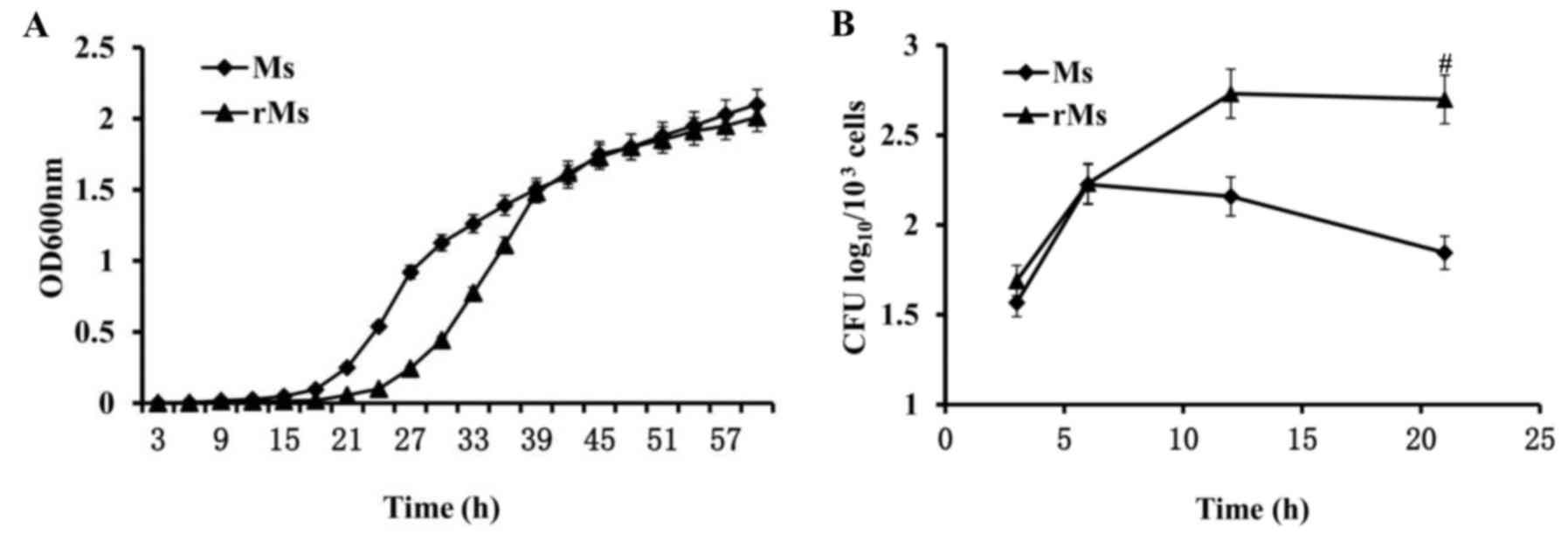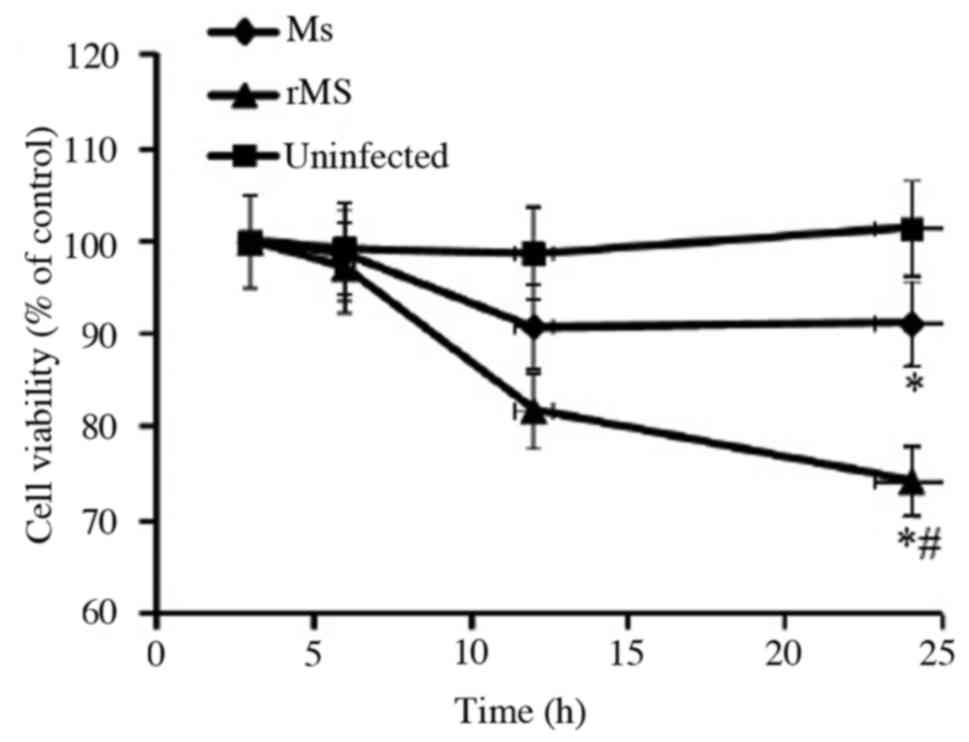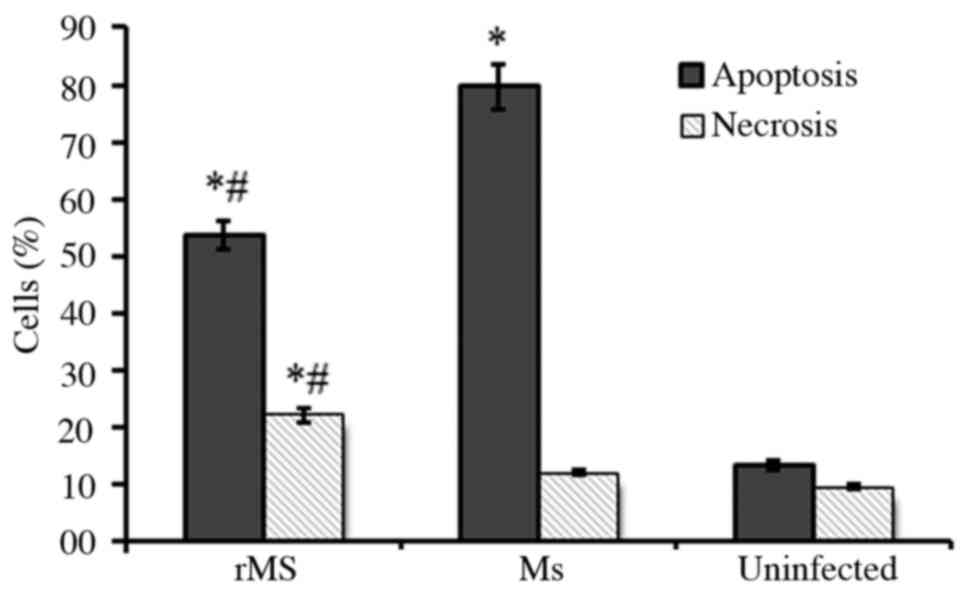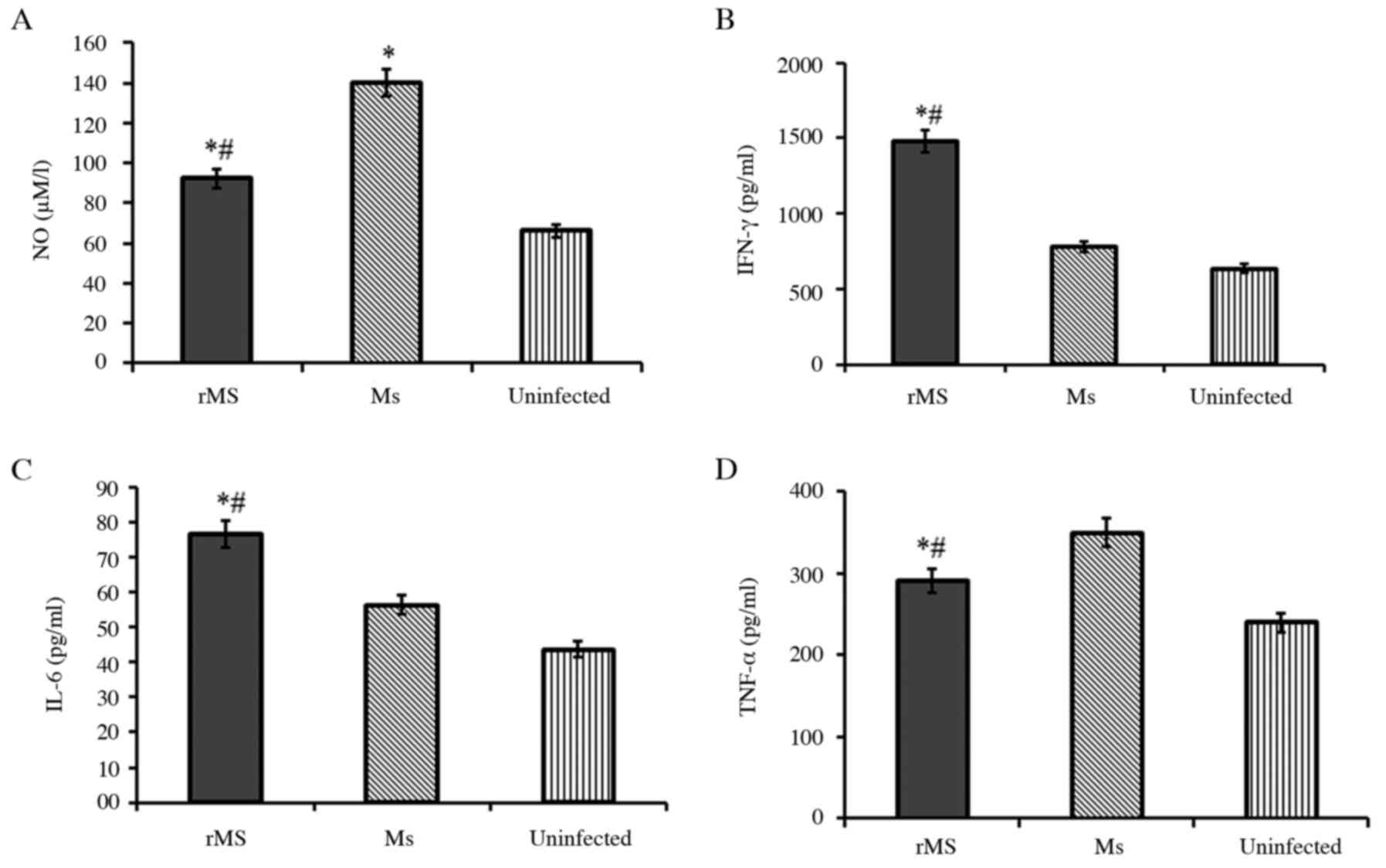Expression of Rv2031c-Rv2626c fusion protein in Mycobacterium smegmatis enhances bacillary survival and modulates innate immunity in macrophages
- Authors:
- Published online on: March 16, 2018 https://doi.org/10.3892/mmr.2018.8758
- Pages: 7307-7312
Abstract
Introduction
Tuberculosis (TB) is a worldwide public health concern caused by Mycobacterium tuberculosis (Mtb), and ~ a third of the world's population is latently infected with Mtb (1). The majority of infected people do not present symptoms immediately, but ~10% of those people develop an overt disease later in their lives. Latently infected individuals represent a reservoir of infection and potential reactivation of TB can be a source of transmission (2). Macrophages represent a primary target of infection and the most frequently infected cell type by Mtb in host individuals. The initial interaction between macrophages and Mtb determines the outcome of infection, but the mechanism underlying the interaction between macrophages and Mtb remains to be elucidated (3).
It has been demonstrated that during the latency period, Mtb remains in a dormant or non-replicating state, and the dormancy survival regulon (DosR), composed of 48 co-regulated genes, is necessary for survival of dormant Mtb (4). However, the role of dormancy-associated antigens in mediating interactions between Mtb and macrophages remains to be elucidated. The 16-kDa α-crystallin protein, (Rv2031c), also known as hspX, acr and Hsp16.3, is a predominant protein produced by Mtb, accounting for up to 25% of all proteins expressed during dormancy of Mtb (5). Rv2031c can be identified by mass spectrometry in culture filtrates, membrane protein fractions and whole cell lysates of Mtb (6). Rv2031c has been hypothesized to enhance long-term stability of proteins and cell structures, which in turn aids in maintaining long-term survival of Mtb (7). Rv2626c is a hypoxic response protein encoded by Mtb open reading frame Rv2626c. Rv2626c is also one of the highly expressed proteins by Mtb in hypoxic conditions and can be identified in culture filtrates and lysates of Mtb (8), but the role served by Rv2626c remains to be elucidated.
In the present study, a fusion protein of Rv2031c and Rv2626c was expressed in a non-pathogenic, fast growing Mycobacterium semegmatis (Ms), to describe the physiological function of the fusion protein in mycobacteria and to investigate its immuno-modulatory functions in macrophages.
Materials and methods
Strains of bacteria, media and growth conditions
The Ms strain MC2 155 was purchased from the American Type Culture Collection (ATCC; Manassas, VA, USA). Bacillus Calmette-Guérin (BCG) was obtained from Shaanxi Research Institute for Tuberculosis Control and Prevention (Shaanxi, China). Mycobacterial strains Ms mc2155 and BCG were cultured in Middle brook 7H9 broth and 7H10 agar (Difco Laboratories, Detroit, MI, USA) containing albumin dextrose complex [5 g bovine serum albumin (Sigma-Aldrich; Merck KGaA, Darmstadt, Germany) 2 g glucose and 0.85 g NaCl/l], 0.5% volume/volume (v/v) glycerol and 0.05% Tween-80. E. coli DH5α (Takara Biotechnology Co., Ltd., Dalian, China) was cultured in Luria Bertani media (Takara Biotechnology Co., Ltd.). Both E. coli and mycobacteria were cultured at 37°C in an incubator, with agitation. Hygromycin (Sigma-Aldrich; Merck KGaA) was added to certain treatment groups: 50 mg/ml to the E. coli culture and 15 mg/ml to the mycobacteria culture. All recombinant (r)Ms strains were cultured in the presence of 15 mg/ml hygromycin.
Construction of rMs strain expressing rv2031c-rv2626c fusion protein
In order to construct a rMs strain expressing Rv2031c-Rv2626 fusion protein, an expression vector was constructed by cloning Rv2031c and Rv2626 genes into the E. coli-Mycobacterium shuttle vector pDE22 (constructed in-house) (Fig. 1) (9). Primers were designed based on nucleotide sequences of Rv2031c and Rv2626c genes from the Mtb H37Rv strain. Rv2031 gene was amplified using the following primers: 5′-CGGGATCCATGGCCACCACCCTTC-3′ (BamHI site underlined; forward) and 5′-AGCGATATCGTTGGTGGACCGG-3′ (EcoRV site underlined; reverse). Rv2626c gene was amplified using the following primers: 5′-AGCGATATCGGTGGCGGTAGCGGCGGTGGCTCCGGCGGTGGCAGCGGTGGCGGTAGCACCACCGCACGC-3′ (EcoRV site underlined; forward) and 5′-AGCAAGCTTCTAGCTGGCGAGGGC-3′ (HindIII site underlined; reverse). A 48-base pair sequence encoding a hydrophobic linker (italics) was added in the linker sequence between the 3′end of Rv2031c and the 5′end of Rv2626c to ensure the correct folding of each protein. The following thermocycling conditions were used for the polymerase chain reaction (PCR): Following an initial denaturation at 95°C for 1 min, 30 cycles of 94°C for 45 sec, 65°C for 45 sec, 72°C for 50 sec; and a final extension at 72°C for 5 min. Sequences of all resulting PCR products were validated by Sunny Biotechnology Co. (Westmont, IL, USA) and the correct sequences were identical to those reported by the GeneBank database. PCR products corresponding to each gene were cloned into the multiple cloning site region of the shuttle vector pDE22 using restriction endonucleases. The resulting recombinant plasmids were transfected into competent Ms cells by electroporation, and the transformed Ms were selected on solid 7H10 agar containing hygromycin (50 µg/ml; Sigma-Aldrich, Merck KGaA) for 3 days. Following selection, hygromycin-resistant colonies were transferred to fresh middlebrook 7H9 media with 15 mg/ml hygromycin. The optical density was measured at a wavelength of 600 nm (OD600nm) and when a colony reached OD600nm = 1.0, cells were incubated at 42°C for 4 h.
A total of 2 ml of each cell culture was harvested by centrifuging at 8,000 × g for 20 min at room temperature. The supernatant was transferred into an Amicon ultrafiltration tube with a membrane NMWL of 10 kDa, centrifuged at 3,000 × g at 4°C until approximately 10 µl fluid remained in the chamber, before adding 100 µl sterile-distilled water and centrifuged again at 3,000 × g at 4°C until ~10 µl fluid remained in the chamber. After centrifugation, the upper chamber of the unltrfiltraion tube was transferred to a fresh mirofuge tube and centrifuged at 3,000 × g at 4°C for 2 min, and the volume in the tube was determined and added to an equal volume of 2X SDS-PAGE sample buffer. The cell pellet was resuspended in 1 ml sterile-distilled water and re-centrifuged at 8,000 × g for 10 min at room temperature, then resuspended in 100 µl sterile-distilled water and sonicated on ice using 4 pulses for 15 sec on maximum output, then 100 µl 2X SDS-PAGE sample buffer was added. A total of 10 µl samples were loaded onto an 12% SDS-PAGE gel and proteins from gel were electrotransferred to a polyvinylidene difluoride membrane (pore size 0.2 µm; Bio-Rad Laboratories, Inc., Hercules, CA, USA) at 70 V for 2 h at 4°C in Tris-Glycine transfer buffer composed of 25 mM Tris, 192 mM glycine and 20% methanol at pH 8.3.
For immunoblotting, non-specific binding sites were blocked with PBS containing 5% non-fat milk for 1 h at room temperature. Blocked membranes were incubated overnight at 4°C in PBS with mouse anti-Rv2031c monoclonal antibody (cat. no. ab64786, dilution 1:500), mouse anti-Rv2626c monoclonal antibody (cat. no. ab64786, dilution 1:500) (both from Abcam, Cambridge, UK). Washed membranes were incubated 1 h at room temperature with IRDye 800CW anti-mouse antibody (1:5,000; LI-COR Bioscience, Lincoln, NE, USA), washed and immunodetection was performed using an ODYSSEY Infrared Imaging system (LI-COR Bioscience). Following screening, positive recombinant Ms strains were classified as rMs.
In vitro growth kinetics of rMs
To examine the growth pattern of rMs, rMs and Ms strains were cultured until late exponential phase, diluted to OD600 nm = 0.2 and cultured in Middlebrook 7H9. Growth curves were generated by measuring alterations in OD600 nm over time for 57 h.
Macrophage infection
RAW264.7 murine macrophages (provided by Dr. Shi CH, the Fourth Military Medical University, Xi'an, China) were cultured at 37°C in 5% CO2 in Dulbecco's modified Eagle's medium (DMEM) supplemented with 10% (v/v) fetal bovine serum (both from Gibco; Thermo Fisher Scientific, Inc.), 1% L-glutamin and antibiotics [60 mg/ml penicillin G sodium, 50 mg/ml streptomycin sulphate and 30 mg/ml gentamycin sulphate, purchased from Leagene Co., Beijing, China; www.leagene.bioon.com.cn). Cells were seeded in 6-well plates at a density of 0.5×105 cells/well and used for infection 24 h later. Exponentially growing bacteria cultured in the presence of 15 mg/ml hygromycin were pelleted, washed and resuspended in DMEM (without antibiotics) to OD600 nm = 1.0. Single cell suspensions of rMs and Ms strains were obtained by passing cultures ~5–6 times through 26 gauge needles. Bacillary viability was assessed at each step by colony-forming unit (CFU) counts. Equal numbers of each strain were used to infect macrophages at a multiplicity of infection (MOI) =10:1, selected based on pilot infections (data not shown) with multiple MOIs that we performed with cell lines used in the present study. Following incubation with bacteria for 4 h, non-phagocytosed bacteria were washed off using PBS. Cells were washed with PBS and post-infection CFU counts were determined by lysing infected cells. Subsequently, complete DMEM containing gentamycin (Gibco; Thermo Fisher Scientific, Inc.) was added to eliminate extracellular bacteria. Infected cells were transferred to fresh DMEM and incubated for 24 h at 37°C with 5% CO2. Following the incubation, 20 µl MTT (Sigma-Aldrich; Merck KGaA) was added to each sample. Following 4 h of incubation with MTT, dimethyl sulfoxide was added and the samples were incubated at 37°C for 10 min. Each sample was observed under an optical microscope and the absorbance was measured at a wavelength of 490 nm on a microplate reader (Omega Bio-Tek, Inc., Norcross, GA, USA). CFU counts were performed at 3, 6, 12 and 21 h post infection by lysing 1×103 infected cells with 0.1% Triton X-100 (Sigma-Aldrich; Merck KGaA) followed by dilution plating on Middlebrook 7H10 agar, the results were expressed as log10 CFU/103 cells.
Apoptosis and necrosis of macrophages
RAW264.7 murine macrophages (105 cells) were left uninfected as controls or infected with Ms or rMs at 10:1 MOI for 24 h. Macrophages were subsequently removed from plates using accutase solution (Sigma-Aldrich; Merck KGaA), washed twice in ice-cold PBS and stained with propidium iodide (PE)-conjugated Annexin V and 7-aminoactinomycin D (7AAD), according to the manufacturer's protocol (BD Biosciences). Cells were fixed in PBS containing 5% paraformaldehyde (Sigma-Aldrich; Merck KGaA) for 20 min at room temperature and analyzed with a FACSCanto II cytometer and FACSDiva software (version 6.1.2; BD Biosciences). Apoptosis was expressed as the percentage of Annexin V-positive 7-AAD-negative cells, and necrosis was expressed as the percentage of Annexin V and 7-AAD-double positive cells.
Cytokine and nitrite assays
Levels of interferon-γ (IFN-γ), tumor necrosis factor-α (TNF-α) and interleukin (IL)-6 in macrophage culture supernatants 24 h post infection were quantitated with a mouse IFN-γ ELISA development kit (cat. no. 3321–1H-6), mouse TNF-α development kit (cat. no. 3511-1H-6) and mouse IL-6 ELISA development kit (cat. no. 3361-1H-6) according to the manufacturer's instructions. All the kits were purchased from Mabtech AB, Stockholm, Sweden. Estimation of nitric oxide (NO) levels was performed using the Griess test. Equal volumes of cell culture supernatants were transferred in duplicate into 96-well culture plates and mixed with an equal volume of Griess reagent, composed of 1% weight/volume (w/v) sulphanilamide, 0.1% (w/v) napthyl-ethylenediamine hydrochloride and 2.5% (v/v) H3PO4. Following incubation at room temperature for 5 min, the absorbance was measured at a wavelength of 540 nm using an Ultra Microplate Reader (Omega Bio-Tek, Inc., Norcross, GA, USA). The concentration of nitrate was calculated using a NaNO2 standard curve.
Statistical analysis
All experiments were performed in triplicate. Differences between groups were analyzed by one-way analysis of variance using SPSS software (version 15.0; SPSS, Inc., Chicago, IL, USA), followed by the Fisher-Tukey least significant difference post hoc test. Data are presented as the mean ± standard deviation. P<0.05 was considered to indicate a statistically significant difference.
Results
Expression of Rv2031c-Rv2626c fusion protein in rMs
Total proteins from whole cell lysates of rMs and Ms strains were obtained following induction at 42°C. Western blot analysis revealed that a specific expression band ~34 kDa, corresponding to the combined molecular weight of Rv2031c (16.3 kDa) and Rv2626c (16 kDa), was present in the cell lysate of rMs, and absent in Ms cells (Fig. 2A). The above results were further confirmed by western blot analysis with anti-Rv2031c and anti-Rv2626 monoclonal antibodies, which indicated that both Rv2031c and Rv2626c were correctly folded in the Rv2031c-Rv2626c fusion protein (Fig. 2B).
Intracellular and in vitro growth characteristics of rMs
In order to determine whether the expression of Rv2031c-Rv2626c fusion protein in rMs alters growth characteristics of the strain, growth rates of rMs and Ms in vitro cultures were identified by OD600 nm measurement. When log-phase cultures of rMs and Ms were allowed to grow to saturation and were equivalently diluted, the duration of the growth lag phase of rMs was significantly prolonged in rMs compared with Ms (P<0.05). The final log-phase rates were not significantly different (Fig. 3A). To identify intracellular growth characteristics of rMs and Ms, infectivity and intracellular survival ability of rMs and Ms in RAW264.7 murine macrophages were examined by CFU estimation of viable bacteria. The results demonstrated that similar numbers of cells (1.99±0.09 log10 CFU for rMs and 1.86±0.10 log10 CFU for Ms) were present 3 h following infection, suggesting that infectivity of rMs was unaffected by transfection. However, 21 h following infection, growth of rMs in macrophages was enhanced and the number of viable bacteria in 103 macrophage cells was equal to 2.70±0.14 lgCFU, which was significantly increased compared with 1.85±0.07 lgCFU in macrophages infected with Ms (P<0.05; Fig. 3B). The above results revealed a significant difference in survival ability inside macrophages between rMs and Ms, potentially associated with expression of Rv2031c-Rv2626c fusion protein in rMs.
Effect of rMs on viability of macrophages
To determine the effect of rMs on viability of macrophages, MTT analysis was performed at different time points following infection of RAW264.7 murine macrophages with rMs or Ms. A total of 24 h following infection, the viability of macrophages was equal to 78.8±3.9% in cells infected with rMs, 90.9±4.5% cells infected with Ms and 101.4±5.1% in uninfected control cells. Both rMs and Ms inhibited the viability of macrophages (P<0.05); however, the viability of macrophages infected with rMs demonstrated a significant decrease compared with Ms from 12 h onwards (P<0.05; Fig. 4). The above results indicate that rMs may be more virulent compared with Ms.
Apoptosis and necrosis of macrophages
RAW264.7 murine macrophages infected with rMs or Ms were stained with PE-conjugated Annexin V and 7AAD, and analyzed by flow cytometry to identified apoptotic and necrotic cells. A total of 24 h following infection, 50.6±3.2% macrophages infected with rMs were apoptotic and 20.7±2.2% were necrotic, while 80.2±4.6% Ms infected macrophages were apoptotic and 15.3±1.4% were necrotic. Compared with Ms, rMs significantly inhibited apoptosis and induced necrosis of infected macrophages (P<0.05; Fig. 5). The above results can be associated with expression of Rv2031c-Rv2626c fusion protein by rMS.
Modulatory effects of rMs on the innate immunity of macrophages
To identify factors contributing to the increased survival ability of macrophages infected with rMs, compared with Ms, levels of nitric oxide were measured by Griess assay. NO is a determinant of intracellular bacillary burden in host cells. Following infection, NO was down-regulated in macrophages infected with rMs, compared with macrophages infected with Ms (P<0.05; Fig. 6A). Levels of IFN-γ, IL-6 and TNF-α in infected macrophages were determined by ELISA. The results demonstrated that secretion of IFN-γ and IL-6 in macrophages infected with rMs was significantly up-regulated (P<0.05), but levels of TNF-α were down-regulated (P<0.05), compared with macrophages infected with Ms. The above results demonstrate that expression of Rv2031c-Rv2626c fusion protein in rMs can modulate the innate immunity of macrophages infected with rMs to favor intracellular survival of rMs.
Discussion
It has been demonstrated that DosR regulon, composed of 48 co-regulated genes, is essential for the survival of Mtb in macrophages (10). Dormancy-associated antigens encoded by DosR genes in Mtb serve physiological and immuno-modulatory functions of the host immune system (11,12). In the present study, a fusion protein of dormancy-associated antigens Rv2031c and Rv2626c was expressed in a non-pathogenic strain of Ms. The results of the present study demonstrated that expression of the fusion protein Rv2031c-Rv2626c in rMs prolonged the duration of growth lag-phase of rMs in vitro. The aforementioned data are consistent with a previous report, in which overexpression of Rv2031c in Ms resulted in a significant lag in growth of Ms (5). In order to determine whether expression of Rv2031c-Rv2626c alters the intracellular survival ability of Ms, macrophages were infected with rMs or Ms. Compared with the Ms strain, infectivity of rMs was not affected by expression of the fusion protein Rv2031c-Rv2626c. Virulence and survival of rMs in macrophages were enhanced, the number of viable cells in macrophages infected with rMs was markedly decreased and the number of intracellular rMs bacteria increased. A previous study reported that a Mtb mutant, in which Rv2031c gene was replaced by a hygromycin resistance gene, was attenuated and demonstrated inhibited growth in a macrophage model (7); however, Hu et al (13) reported that increased numbers of CFU were observed in mice or macrophages that they were infected with an unmarked Rv2031c deletion mutant of Mtb when compared with the orginal Mtb strain.
It has been reported that virulent Mtb can inhibit apoptosis and trigger necrosis of host macrophages to evade innate immunity and delay the initiation of adaptive immunity (3). By contrast, attenuated Mtb and non-pathogenic mycobacteria induce apoptosis of macrophages, an innate defense mechanism that reduces bacterial viability (14,15). Therefore, in the present study, apoptosis and necrosis of infected macrophages were observed. The results of the present study demonstrated that, compared with Ms, apoptosis of macrophages infected with rMs was decreased, while necrosis was increased. NO production is an antimicrobial mechanism employed by macrophages (16). In the present study, compared with macrophages infected with Ms, macrophages infected with rMs demonstrated decreased NO levels in macrophages. Therefore, it can be hypothesized that inhibition of NO enhanced the survival of rMs in macrophages.
Macrophages eliminate invading Mtb directly and secrete cytokines to mediate host immune responses (17). The present study investigated secretion of IFN-γ, TNF-α and IL-6 from infected macrophages. The results of the present study demonstrated that levels of IFN-γ and IL-6 markedly increased compared with macrophages infected with Ms, while the levels of TNF-α decreased. TNF-α is an extrinsic mediator of apoptosis, which has been demonstrated to have a negative impact on the survival of mycobacteria within macrophages. More virulent strains appear to inhibit expression of TNF-α (18). It can be hypothesized that reduced apoptosis of macrophages infected with rMs may be associated with inhibition of expression of TNF-α, but the underlying mechanism remains to be elucidated.
In conclusion, the present study demonstrated that expression of the fusion protein of dormancy-associated antigens Rv2031c and Rv2626c in Ms can serve a physiological function of a dormancy-associated antigen. The fusion protein also modulated the innate immunity of host macrophages, favoring intracellular bacillary survival. However, the mechanism underlying intracellular survival mediated by dormancy-associated antigens in Mtb, remain to be elucidated.
Acknowledgements
The present study was supported by the National Science and Technology Major Project of China (grant no. 2012ZX10003008-007) and the National Natural Science Foundation of China (grant no. 31501112).
References
|
World Health Organization (WHO): Global Tuberculosis Report. WHO; Geneva: pp. 2042015 | |
|
Gideon HP and Flynn JL: Latent tuberculosis: What the host ‘sees’? Immunol Res. 50:202–212. 2011. View Article : Google Scholar : PubMed/NCBI | |
|
Liu PT and Modlin RL: Human macrophage host defense against Mycobacterium tuberculosis. Curr Opin Immunol. 20:371–376. 2008. View Article : Google Scholar : PubMed/NCBI | |
|
Gerasimova A, Kazakov AE, Arkin AP, Dubchak I and Gelfand MS: Comparative genomics of the dormancy regulons in mycobacteria. J Bacteriol. 193:3446–3452. 2011. View Article : Google Scholar : PubMed/NCBI | |
|
Yuan Y, Crane DD and Barry CE III: Stationary phase-associated protein expression in Mycobacterium tuberculosis: function of the mycobacterial alpha-crystallin homolog. J Bacteriol. 178:4484–4492. 1996. View Article : Google Scholar : PubMed/NCBI | |
|
de Souza GA1, Arntzen MØ, Fortuin S, Schürch AC, Målen H, McEvoy CR, van Soolingen D, Thiede B, Warren RM and Wiker HG: Proteogenomic analysis of polymorphisms and gene annotation divergences in prokaryotes using aclustered mass spectrometry-friendly database. Mol Cell Proteomics. 10:M110.0025272011. View Article : Google Scholar : PubMed/NCBI | |
|
Yuan Y, Crane DD, Simpson RM, Zhu YQ, Hickey MJ, Sherman DR and Barry CE III: The 16-kDa alpha-crystallin (Acr) protein of Mycobacterium tuberculosis is required for growth in macrophages. Proc Natl Acad Sci USA. 95:pp. 9578–9583. 1998; View Article : Google Scholar : PubMed/NCBI | |
|
Rosenkrands I, Slayden RA, Crawford J, Aagaard C, Barry CE III and Andersen P: Hypoxic response of Mycobacterium tuberculosis studied by metabolic labeling and proteome analysis of cellular and extracellular proteins. J Bacteriol. 184:3485–3491. 2002. View Article : Google Scholar : PubMed/NCBI | |
|
Gao H, Bai Y, Xue Y, Wang L, Fan A, Ding X and Xu Z: Expression, purification, and characterization of soluble RpfD with high bioactivity as a recombinant protein in Mycobacterium vaccae. Protein Expr Purif. 55:112–118. 2007. View Article : Google Scholar : PubMed/NCBI | |
|
Boon C and Dick TP: How Mycobacterium tuberculosis goes to sleep: The dormancy survival regulator DosR a decade later. Future Microbiol. 7:513–518. 2012. View Article : Google Scholar : PubMed/NCBI | |
|
Singh S, Saraav I and Sharma S: Immunogenic potential of latency associated antigens against Mycobacterium tuberculosis. Vaccine. 32:712–716. 2014. View Article : Google Scholar : PubMed/NCBI | |
|
Serra-Vidal MM, Latorre I, Franken KL, Díaz J, de Souza-Galvão ML, Casas I, Maldonado J, Milà C, Solsona J, Jimenez-Fuentes MÁ, et al: Immunogenicity of 60 novel latency-related antigens of Mycobacterium tuberculosis. Front Microbiol. 5:5172014. View Article : Google Scholar : PubMed/NCBI | |
|
Hu Y, Movahedzadeh F, Stoker NG and Coates AR: Deletion of the Mycobacterium tuberculosis alpha-crystallin-like hspX gene causes increased bacterial growth in vivo. Infect Immun. 74:861–868. 2006. View Article : Google Scholar : PubMed/NCBI | |
|
Srinivasan L, Ahlbrand S and Briken V: Interaction of Mycobacterium tuberculosis with host cell death pathways. Cold Spring Harb Perspect Med. 4:pii: a022459. 2014. View Article : Google Scholar : PubMed/NCBI | |
|
Fratazzi C, Arbeit RD, Carini C, Balcewicz-Sablinska MK, Keane J, Kornfeld H and Remold HG: Macrophage apoptosis in mycobacterial infections. J Leukoc Biol. 66:763–764. 1999. View Article : Google Scholar : PubMed/NCBI | |
|
Ferrari CK, Souto PC, França EL and Honorio-França AC: Oxidative and nitrosative stress on phagocytes' function: From effective defense to immunity evasion mechanisms. Arch Immunol Ther Exp (Warsz). 59:441–448. 2011. View Article : Google Scholar : PubMed/NCBI | |
|
O'Garra A, Redford PS, McNab FW, Bloom CI, Wilkinson RJ and Berry MP: The immune response in tuberculosis. Annu Rev Immunol. 31:475–527. 2013. View Article : Google Scholar : PubMed/NCBI | |
|
Beham AW, Puellmann K, Laird R, Fuchs T, Streich R, Breysach C, Raddatz D, Oniga S, Peccerella T, Findeisen P, et al: A TNF-regulated recombinatorial macrophage immune receptor implicated in granuloma formation in tuberculosis. PLoS Pathog. 7:e10023752011. View Article : Google Scholar : PubMed/NCBI |




